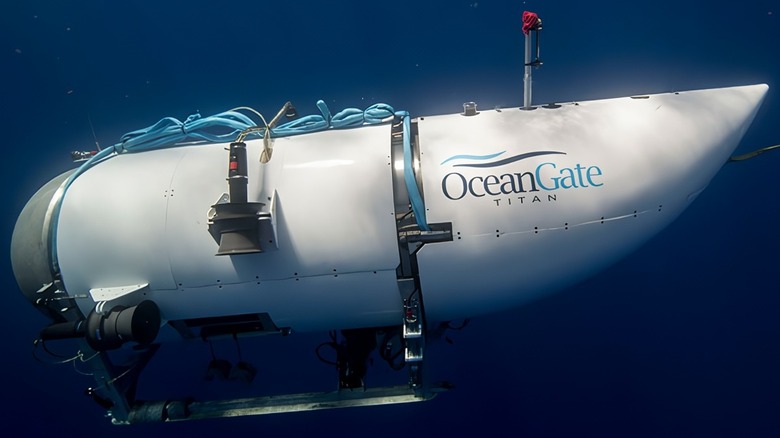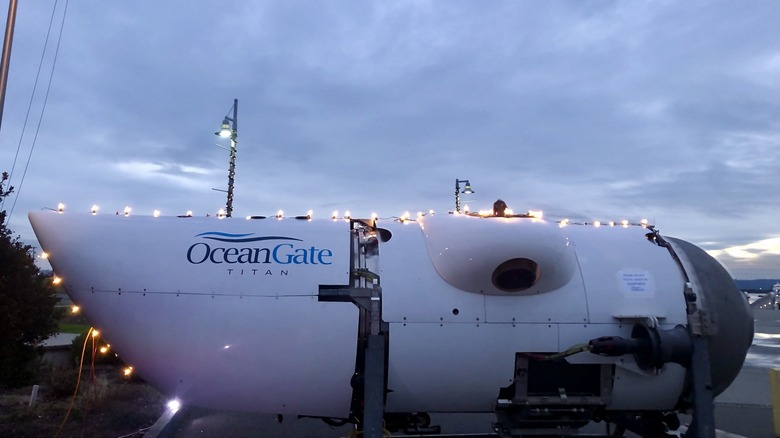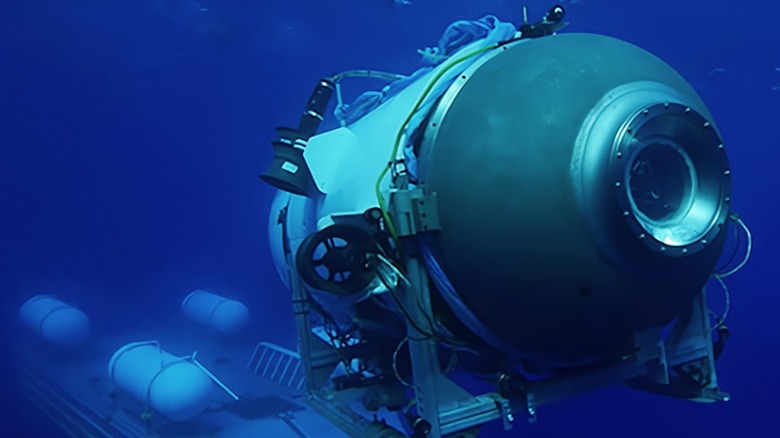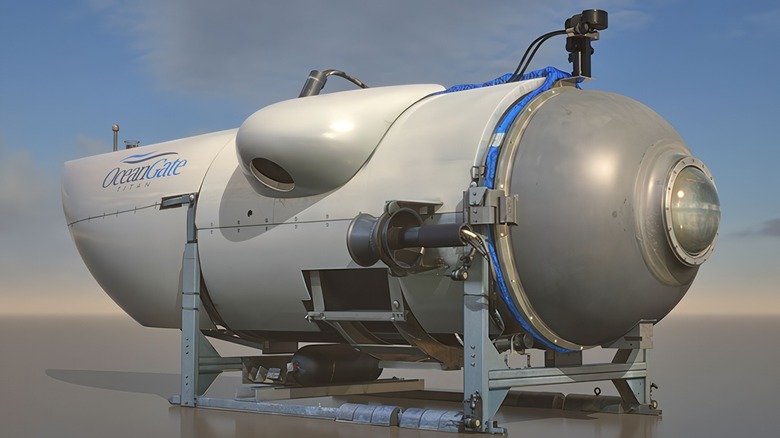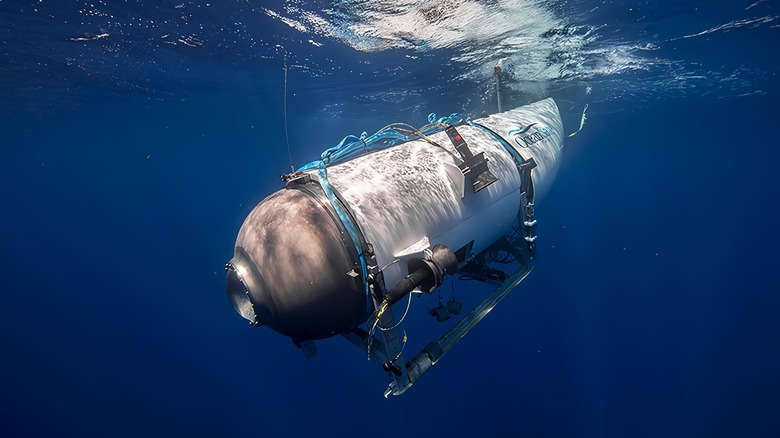The Controversial Tech Behind The Missing Titanic Submersible
OceanGate Expeditions' Titan submersible vehicle, which embarked on an underwater tour of the Titanic's historical wreckage, still hangs in uncertainty while rescue operations are in full swing. The Titan, which was carrying five passengers, lost contact with the surface communication ship just shy of two hours after it was detached from the launch platform aboard the research vessel named Polar Prince. Government and private authorities are putting in all efforts to rescue the five-person crew, but so far, they haven't had any luck.
Titan's design, maneuvering systems, and safety protocols have attracted questions since the company first started offering Titanic sightseeing rides to its rich clientele at $250,000 per person. The company's unorthodox approach to not getting the Titan submersible "classed" by a regulatory authority also raised concerns as it continued with its underwater sight-seeing services. Moreover, the ship's unique engineering has led many to believe that a successful rescue mission is going to be extremely difficult.
A game controller and touch displays
CBS reporter David Pogue was part of a Titan crew in 2022, during which he revealed a few worrying nuggets of information about the submersible vessel's design. For example, he said that the vessel was piloted with a Logitech F710 wireless game controller that had some modifications done, such as substituting the direction joysticks with a pair of custom sticks for better navigation.
Now, one can argue that if the U.S. Navy can use Xbox 360 controllers with its submarines, why can't the Titan? Well, there's a crucial difference here: the Navy uses the controller to operate a submarine's periscopes rather than relying on it to maneuver the vehicle. As well, the Logitech F710 is a cheap controller that was first released on the market more than a decade ago. When it comes to matters of life and death, it seems like using such an old, inexpensive controller is an unusual choice.
In addition, there is said to be only a single button inside the vessel (to turn it on), with the rest of the control systems involving computers and digital displays — much in the same way that many modern cars have replaced buttons and dials with touch screens. While the design was intended to make operating the submersible a low-skill task, that same design may be a problem if the submersible has lost all electrical power, particularly as it is dependent on Starlink for communications.
The door can only be opened from the outside
Because Titan is a submersible rather than a submarine, it cannot bring itself back to the surface — rather, it is dependent on a nearby ship, which it also relies on for navigation. To help get around that, submersibles are typically designed with a drop weight designed to break free from the vehicle after a certain amount of time has passed, after which point the submersible will bob to the surface of the ocean. The Titan is equipped with this kind of drop weight, as well as reflectors and other features that would make it more visible to nearby vessels.
That increases the odds of rescuers finding the submersible, as recovery will be incredibly difficult if it is free-floating thousands of feet under the surface. However, Titan's hatch can only be opened from the outside, meaning the crew won't be able to open it themselves to let in oxygen even if the submersible does reach the surface. During his brief ride inside the Titan, CBS' Pogue explained, "The crew closes the hatch, from the outside, with 17 bolts. There's no other way out." Titan contains 96 hours worth of oxygen, which is enough to last four days — of which two have elapsed, at the time of writing, as the Titan went off-radar on June 18.
Space and supplies are limited
The Titan submersible is quite small and cramped with an interior space around the size of a minivan, and that leaves little room for non-essentials — not to mention, it's not even possible to stand up and stretch inside the small vehicle. Unlike some submersibles, OceanGate notes that its Titan is equipped with a "toilet," though based on demonstrations the company has given, it's not going to be able to accommodate five people for multiple days in a row, as it was intended only to be used in a moment of urgency during a research trip lasting around 10 hours.
Then there's the matter of fresh water and food. OceanGate Expeditions' website mentions tourists can take a bag of sandwiches for lunch with them, but it won't last four days. It's unclear at the time of writing whether the vessel is equipped with enough drinking water to sustain the passengers for a few days.
Titan doesn't have a stamp of regulatory approval
The Titan hasn't been approved or certified by any regulatory authority. In technical terms, it hasn't been classed. OceanGate Expedition argued that awaiting regulatory vetting stifles innovation, and company CEO Stockton Rush noted in 2019 that the company worked with experts at NASA, Boeing, and the University of Washington on Titan's engineering.
In fact, OceanGate Expeditions has a dedicated post up on its website titled "Why Isn't Titan Classed," in which it explains why it didn't go through the regulatory approval process. The post highlights some possible issues with the classing procedure, but some of the claims sound overly confident. "Bringing an outside entity up to speed on every innovation before it is put into real-world testing is anathema to rapid innovation," it reads.
OceanGate said that the Titan's predecessor was classed, but the Titan itself isn't. Likewise, the company said it worked with "a premier classing agency" to validate each depth plan for Titan missions, with a licensed marine surveyor assessing each dive and performing a post-mission inspection. However, a new report from The New York Times claims that OceanGate was warned by industry experts that Titan had multiple issues that may eventually lead to a "catastrophic" outcome for tourists. OceanGate's CEO reportedly responded to those concerns with a statement similar to that of the blog post about classification stifling innovation.
